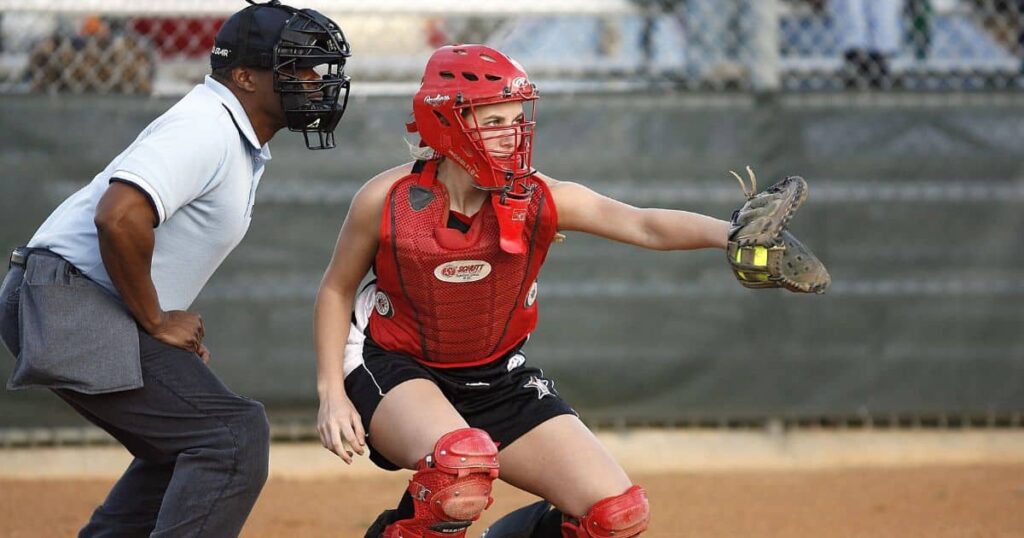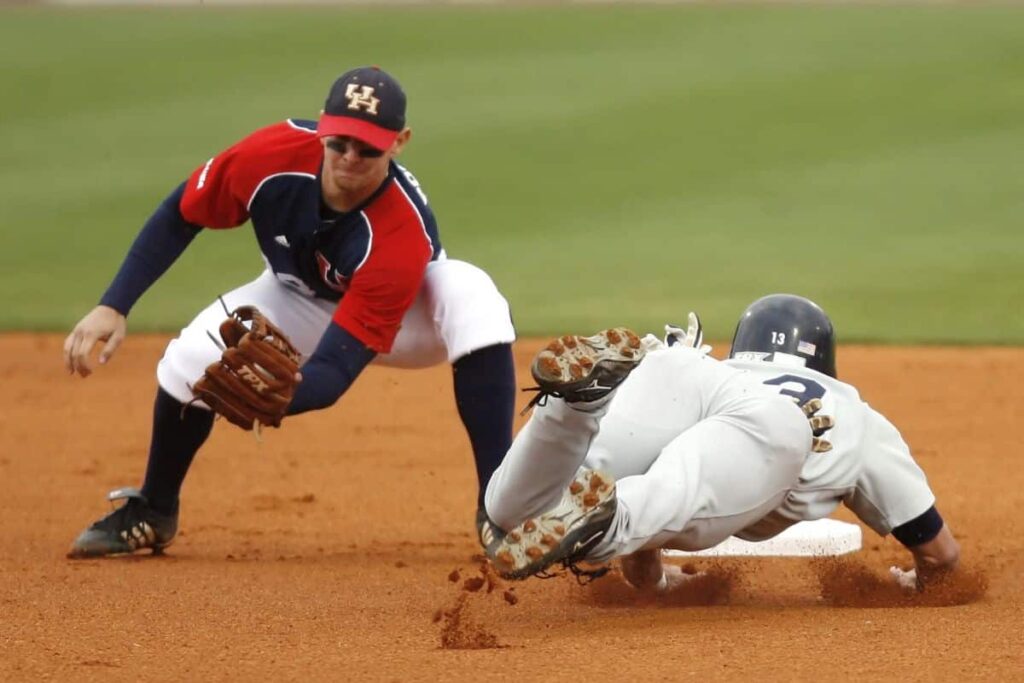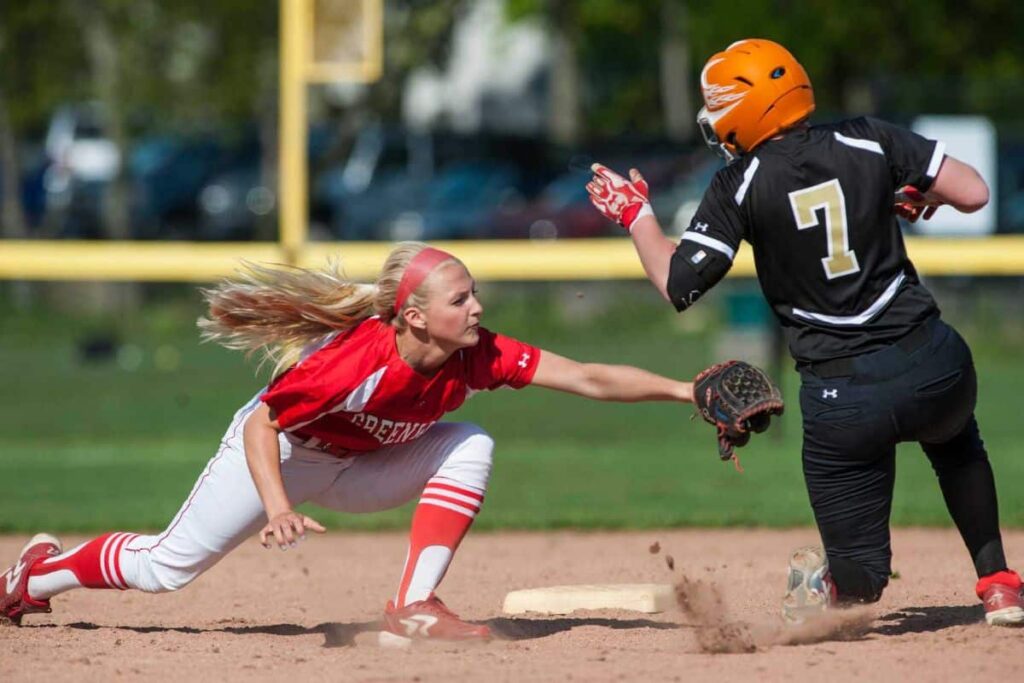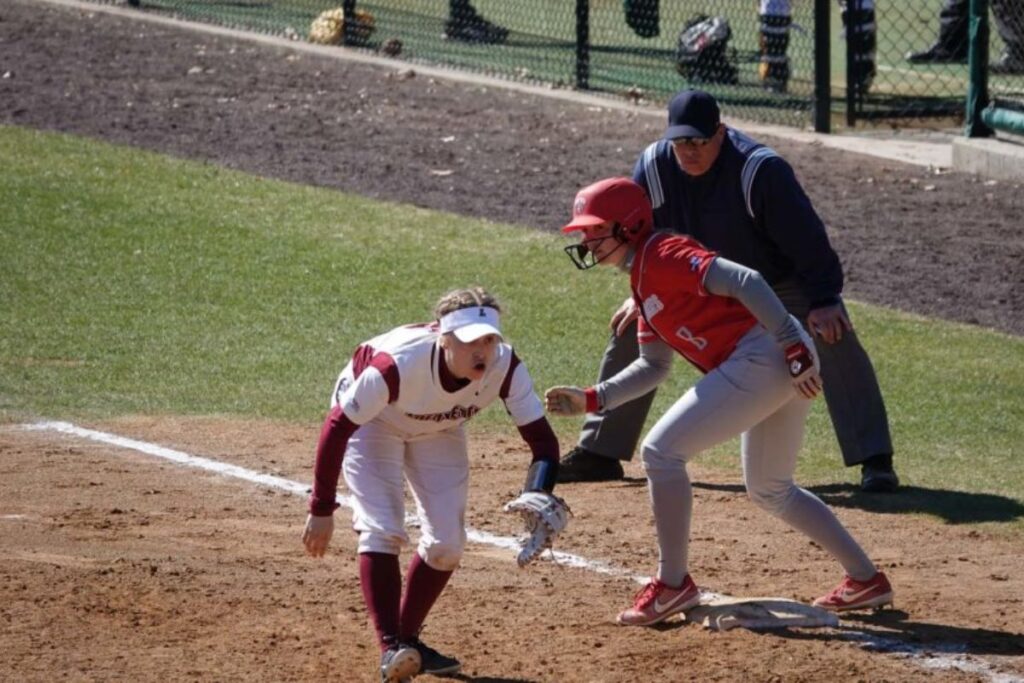Softball is a popular team sport that requires players to fill specific positions on the field. The 9 main positions in softball are pitcher, catcher, first base, second base, third base, shortstop, left field, center field, and right field. Additionally, the batter position rounds out the key roles.
Each softball position comes with key responsibilities and required skills to succeed. Understanding the attributes for each role helps players find where they fit best on a team. This guide will break down the softball positions and what it takes to play them well.
9+1 Positions In Softball
In softball, there are six infields and three outfielders. Oh, and one offensive position. I’ll start with the pitcher!
1. Pitcher (P)

The pitcher is one of the most important positions in softball. They are responsible for throwing the ball toward home plate to get opposing batters out.
Required Skills & Attributes
To be a successful pitcher, you need to have a strong pitching arm to throw fast and accurately. You also need good control and different pitching techniques like throwing curve balls and fastballs. Pitchers need to be competitive, focused, and strategic in their pitching choices. Core and arm strength are critical to avoid injury and fatigue.
2. Catcher (C)

The catcher crouches behind home plate and catches pitches thrown by the pitcher. They play a key role defensively and in communicating with the pitcher.
Required Skills & Attributes
Catchers need to be durable, agile, and quick reacting to pitches. They must possess great hand-eye coordination to catch pitches cleanly. A strong and accurate throwing arm is also important to catch runners stealing bases. Catchers are defensive leaders so intelligence and communication skills are key. They also need stamina to crouch for long periods.
3. First Base (1b)

The first baseman is responsible for fielding balls hit near first base and catching throws to get runners out.
Required Skills & Attributes
First basemen need good hand-eye coordination and mobility to field ground balls. Height and reach are advantageous to catch errant throws. They also need quick reaction time and awareness to catch line drives. Good catching and throwing skills are vital to make plays after fielding balls. Knowledge of positioning and strategy helps first basemen maximize their defensive impact.
4. Second Base (2b)

Second basemen cover near second base. They work with the shortstop and turn double plays.
Required Skills & Attributes
Second basemen need quick feet and reactions to field balls. Strong and accurate throwing and catching is key to convert double plays. They tend to be shorter but quick players who can cover ground laterally. Instincts and awareness assist in positioning. Good communication with the shortstop and other infielders is also important.
5. Third Base (3b)

Third base is known as the “hot corner” for the hard shots that come down the line. Players field and throw balls quickly to put out runners.
Required Skills & Attributes
Third basemen require quick reflexes and mobility reacting to batted balls. A strong arm allows them to throw runners out from long distance. Soft hands help field hard hit grounders. Intelligence puts them in the right spot and enables smart plays. Communication with other infielders also helps coordinate defensively.
6. Shortstop (Ss)

The shortstop fields balls up the middle and works with second base for double plays. They play a key role defensively as captain of the infield.
Required Skills & Attributes
Shortstops need quick feet and hands combined with a strong arm. They cover a lot of ground so speed and agility are important. Game sense and focus are useful for reading batters. Shortstops also need soft hands for fielding awkward hops. Leadership and communication allow coordinating the infield defense.
7. Left Field (Lf)

Left fielders cover balls hit to left field. They must field and throw quickly to prevent base runners advancing extra bases.
Required Skills & Attributes
Left fielders require good speed and arm strength throwing to bases. Quick acceleration gets them to balls rapidly. Strong awareness and positioning sense lets them anticipate plays. Catching skills help convert putouts. Being vocal helps communicate with center fielders on balls between them.
8. Center Field (Cf)

Center fielders cover the most ground so they must be fast and have good range. They are often the best overall athletes on the team.
Required Skills & Attributes
Center fielders need blazing speed to run down balls in gaps. A strong and accurate throwing arm prevents extra bases. They track balls well and take good routes using speed efficiently. Leadership skills are useful for commanding the outfield. Communication with left and right fielders assists covering ground between them.
9. Right Field (Rf)

Right fielders cover balls hit to right field. They have a strong arm to prevent runners from advancing.
Required Skills & Attributes
Right fielders require excellent arm strength for long throws to third base and home plate. Speed helps cover ground in the gaps. Quick reaction time gets them to balls rapidly. Besides catching and throwing, awareness of game situations helps make smart plays. Communication with center fielders is key on balls between them.
How To Choose A Softball Position?
Choosing the right softball position for yourself isn’t an easy task. It can be very overwhelming. Luckily, there is an easy way to determine a couple of positions from the total nine, which is a great start.
1. Think About Where You Are Good At
Consider your strengths and attributes to find a good fit. Are you very fast or have a cannon arm? Do you excel at hitting for contact or power? Align your skills with position requirements.
2. Think About What You Like To Do The Most
Playing your favorite position boosts motivation and enjoyment. If you love the thrill of sprinting and diving for balls, outfield is a great choice. Do you like catching pitches and calling the game? Catcher may be perfect for you.
Here You’ll Find My Favorite Softball Equipment
Bat
For power hitters, a balanced and end-loaded bat like the DeMarini CF Insane or Louisville Xeno provides optimal swing speed. Contact hitters may prefer a evenly balanced bat like the DeMarini White Steel with its vibration dampening design. Composite, alloy, or hybrid bats give a great feel on contact.
Softball
Opt for a 12 inch softball with a smooth leather cover and concealed seams for catchability and grip. Composite core balls like the Dudley Thunder Heat offer pop off the bat and maximum distance. For indoor play, an 11 or 12 inch polycore softball reduces ball bounce and risk.
Glove
At each position, use a properly sized glove with patterns suited for specific fielding demands. Pitchers need a closed web and shallow pocket to hide grips while infielders benefit from open webs with deeper pockets to handle short hops. Outfielders use larger gloves with wide webbing and deep pockets for catching fly balls.
What Softball Position Is Hardest?
The catcher position is likely the most difficult since it requires specialized skills like blocking pitches in the dirt and framing pitches on the corners. Catchers must also know the strengths of all the pitchers and batters they face. The mental focus and durability to squat for entire games while enduring foul tips also makes catching extremely challenging.
What Position In Softball Has The Strongest Arm?
The center fielder typically has the strongest throwing arm on the softball field. They need to throw long distances up to 300-feet to home plate to throw runners out tagging up from third base. Center fielders also make throws to third base and second base up to 200 feet away. Elite arm strength and accuracy prevents base runners from taking extra bases.
Which Position Player Is The Fastest?
The center fielder is generally the fastest player on the softball field. They need blazing speed to run down balls in the gaps and deep fly balls. Center fielders cover the most ground so having great range and acceleration is essential. Left fielders and right fielders also tend to be very fast to cover the outfield gaps. And shortstops need excellent quickness and agility to get to grounders up the middle and make plays in the hole between third and short.
What Is The Easiest Position In Softball?
First base is typically considered the easiest position because it involves less range and quick reaction time compared to infield positions like shortstop and third base. First basemen mainly receive throws from other infielders rather than fielding sharply hit grounders themselves. With less priority on speed and agility, first base offers the least demanding defensive role on the softball field.
FAQ’s
What Is The Softball Position?
The main defensive positions in softball are pitcher, catcher, first base, second base, third base, shortstop, left field, center field, and right field. The pitcher throws from the rubber to home plate while the catcher squats behind the plate to receive pitches. The four infielders of first base, second base, shortstop and third base protect the dirt infield area. The outfielders of left, center and right field cover balls in the grass outfield.
What Is Position 9 In Softball?
Position 9 in softball is right field. The right fielder covers balls and flys hit to right field. Right fielders typically have one of the strongest throwing arms on the team to make long throws to third base and home plate to prevent runners from advancing extra bases.
How Many Playing Positions Are There In Softball?
There are 9 main defensive positions in softball – pitcher, catcher, first base, second base, third base, shortstop, left field, center field, and right field. Additionally, there is the extra tenth position of batter that bats in a set order to produce runs.
What Is The Most Important Position In Women’s Softball?
The pitcher is the most important position in women’s softball. An elite pitcher who can dominate games with strikeouts, minimal walks, and very few hits allowed gives a team the best chance to win games consistently. A standout pitcher has more influence on the outcome of softball games than any other single position.
What Is Position 10 In Softball?
The 10th position unique to softball is the batter in the lineup. While there are 9 defensive positions in the field, the batter comes to bat in a set order to hit the ball and get on base to generate run scoring. The batting order roles over after 9 batters and the leadoff hitter bats again 10th.
Conclusion
Softball requires players to fill specialized positions, each demanding key skills and attributes. The pitching and catching battery works together to get outs and control the run game. Infielders like the shortstop need quick reflexes, soft hands and strong arms for the close plays on the dirt. Outfielders must cover vast ground with speed and mobility to track down balls. And batters provide pop and production at the plate while utilizing patience and strategy. With practice, players can develop the abilities required to thrive at each spot. Understanding position responsibilities guides athletes to find their fit and contribute to team success. Whether just for fun or competing to win, filling softball’s 9+1 roles with intelligence, hustle and skill makes for an exciting game.








